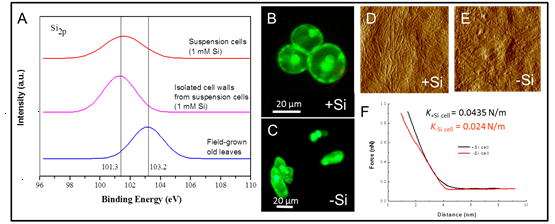硅是植物生长的有益元素之一。大量的植株和器官水平上的研究已经显示硅赋予各种植物许多特殊的功能尤其是能显著地提高植物抵抗环境胁迫的能力,但相应的细胞结构和硅化学机制仍然不清晰。王荔军教授领衔的生物矿化研究小组以水稻悬浮细胞为材料,借助现代物理手段(包括XPS,ICP-MS,AFM和NMT等)发现水稻悬浮细胞中硅不是以二氧化硅的形式存在(Figure 1),而是作为细胞壁组分元素,共价结合到细胞壁基质上,形成一种新的有机硅种类。这种以前未知的有机硅种类,在细胞膨胀过程中能改善细胞壁的力学性质和稳定性,对于维持细胞形状和细胞活性具有重要作用。此外,硅修饰的细胞壁能够提高细胞壁的电负性,进而有效减少细胞对重金属镉的吸收。这些研究结果将有助于揭示植物硅营养的化学本质。相关结果系列发表在New Phytologist上。
(1) Congwu He et al., Evidence for ‘silicon’ within the cell walls of suspension-cultured rice cells. New Phytologist, 2013, 200: 700–709. (IF 6.736)
(2) Jian Liu et al., Inhibition of cadmium ion uptake in rice (Oryza sativa) cells by a wall-bound form of silicon. New Phytologist, 2013, 200: 691–699.

Figure 1. (A) X-ray photoelectron spectroscopy (XPS) characterization of the chemical composition for Si2p of (B, C) the suspension cell surfaces. (D-F) Representative force–distance curves for rice (Oryza sativa) cells cultivated for 3 months in the absence (-Si) and presence (+Si) of silicic acid by atomic force microscopy (AFM).